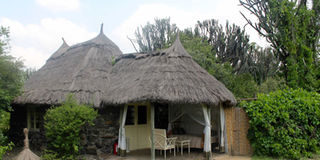Weekend getaway to Mbweha Camp

One of 10 thatched lava stone cottages at Mbweha Camp. PHOTOS | JAN FOX
What you need to know:
- Inside, the cottages are tastefully furnished, with big beds draped with mosquito nets and an array of easy chairs, tables, sheepskin rugs and paintings. At the back the bathrooms are spacious, some of which have outdoor bathtubs, and at the front the verandas are cosy and provide a great spot to listen to and watch the birds flutter between the shrubs.
- Because of the conservancy’s location, and because there is so much to do in the area, Saul recommended that guests stay at the camp for at least two days. The first can be spent exploring the rest of Soysambu Conservancy and the shores of Lake Elementaita, before a night game drive around the camp.
For three years, my dad has been urging me to visit Mbweha Camp. He described their cottages as “among the most inviting, charming and pampering that (he) ever had the pleasure of sleeping and waking up in”.
That’s high praise from someone who has slept in enough rooms to fill 25 years worth of Going Places articles. When he last visited, it was for a “directors’ retreat” – to talk about important things away from his office in Nairobi. I had a more romantic incentive, and as it turned out Mbweha Camp fit the bill perfectly.
The camp is nestled up against the southern border of the Lake Nakuru National Park, within the 6,400 acre Congreve Conservancy – which itself forms part of the much larger 48,000 acre Soysambu Conservancy. To get there, you turn off the main Naivasha-Nakuru road at Lanet and head south along the dead straight tarmac road towards the Eburru Range.
The entrance is only 15 minutes from Lake Nakuru’s Nderit gate. Once in the conservancy, the camp is easy to find, as it’s well signposted and sits within a thicket of Candelabra Euphorbia trees – which stick out like a sore thumb in an otherwise vast open plain.
We arrived to a very warm welcome, and Joseph – the camp manager – showed us around. The camp’s focal point is an inviting sunken lounge and bar, with a wood fire at its heart and a large swooping sofa that encircles it. A small ramp leads to the dining area, and beyond that a gravel path leads to the swimming pool and 10 cottages tucked among the Euphorbias.
I can see why my dad, and many others who recommended it, are drawn to the camp – and to the cottages in particular. Named after a variety of animals found in the conservancy, each cottage is made of chiselled lava stone and a thatched makuti roof, and is shaded and screened from the rest of the camp by a wall of shrubs and trees.
Inside, the cottages are tastefully furnished, with big beds draped with mosquito nets and an array of easy chairs, tables, sheepskin rugs and paintings. At the back the bathrooms are spacious, some of which have outdoor bathtubs, and at the front the verandas are cosy and provide a great spot to listen to and watch the birds flutter between the shrubs.
For us it was the seclusion that made the cottages so attractive: it’s easy to drift far away from the stresses of city life with a beer in a bathtub surrounded by the sights and sounds of the bush. And for those who really don’t want to leave their cottage, you can have breakfast, lunch or dinner set up on your veranda. The camp staff can also arrange meals in the bush, including lunch and sundowners overlooking Lake Nakuru.
The advantage of the camp’s location just outside of Lake Nakuru National Park is that guests can go on night game drives and bush walks – which we found were the best ways to view the conservancy’s wildlife.
Beyond its variety of plains game, the animals are predominantly nocturnal, and the conservancy comes to life at night. Knowledgeable camp guides Saul and Patrick took us on a night game drive in the camp’s open Land Cruiser. Though we didn’t spot the elusive Aardvark we’d hoped to see (but got stuck in one of their many dens) we were lucky enough to see three bat-eared foxes, eight silver-backed jackals, three spotted hyenas and plenty of spring hares – Africa’s mini kangaroos.
In the morning, Saul took us on a bush walk along the fringes of the camp, where we tracked some of the animals we’d seen the night before. It was also a lot easier to appreciate the landscape on foot – with the Mau Range to the west, Aberdares to the east, and the volcanoes Ol Doinyo Eburru to the south and Menengai to the north.
Because of the conservancy’s location, and because there is so much to do in the area, Saul recommended that guests stay at the camp for at least two days. The first can be spent exploring the rest of Soysambu Conservancy and the shores of Lake Elementaita, before a night game drive around the camp.
On the second day, after a morning game drive and lunch in Lake Nakuru National Park, guests can spend the afternoon relaxing in the camp or walking or cycling around the Congreve Conservancy. Camp staff also organise guided hikes up ‘Delamere’s Nose’ and the Menengai Crater, as well as visits to Hyrax Hill and the Kariandusi archaeological site.
The rates are reasonable too: a full board double for residents is Sh8,500 per person in high season and Sh7,500 in low season. Night game drives are Sh3,000 for residents and $45 for non-residents. For non-resident room rates and other enquiries email management at [email protected], have a look at the website at www.atuaenkop.com, or contact Gamewatchers Safaris (www.porini.com)





